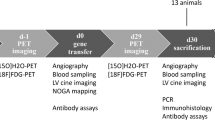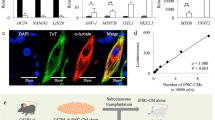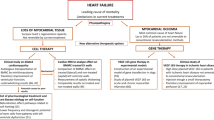Abstract
Cell-based gene therapy offers an alternative strategy for therapeutic angiogenesis for the management of myocardial infarction (MI). However, immune rejection poses a significant obstacle to the implantation of genetically engineered allogeneic or xenogeneic cells. In the present study, an ex vivo gene therapy approach utilizing cell microencapsulation was employed to deliver vascular endothelial growth factor (VEGF) to ischemic myocardium. Chinese hamster ovary (CHO) cells were genetically modified to secrete VEGF and enveloped into semipermeable microcapsules. In vitro assay indicated that the microencapsulated engineered CHO cells could secrete VEGF as high as 3852 pg ml−1 per 48 h at day 8 after encapsulation. Then the microencapsulated CHO cells were implanted into the injured myocardium in a rat MI model, while engineered CHO cells, blank microcapsules and serum-free culture media were implanted as controls. The humoral immunity to xenogeneic CHO cells were evaluated and we found that the titer of anti-CHO antibodies was significantly lower in the microencapsulated CHO transplantation group than the group receiving unencapsulated CHO cells at two weeks after implantation. However, 1 week later, there was almost no difference between these groups. Histology and western blotting confirmed that the microencapsulated CHO cells maintained their original structure and VEGF secretion three weeks after implantation. The capillary density in the treatment region was also significantly higher in the microencapsulated CHO cell group than control groups, which was consistent with gross heart functional improvement. These data suggest that microencapsulated xenogeneic cell-based gene therapy might be a novel approach for therapeutic angiogenesis in ischemic heart disease.
This is a preview of subscription content, access via your institution
Access options
Subscribe to this journal
Receive 12 print issues and online access
$259.00 per year
only $21.58 per issue
Buy this article
- Purchase on Springer Link
- Instant access to full article PDF
Prices may be subject to local taxes which are calculated during checkout






Similar content being viewed by others
References
Madeddu P . Therapeutic angiogenesis and vasculogenesis for tissue regeneration. Exp Physiol 2005; 90: 315–326.
Losordo DW, Dimmeler S . Therapeutic angiogenesis and vasculogenesis for ischemic disease: part II: cell-based therapies. Circulation 2004; 109: 2692–2697.
Stewart DJ, Hilton JD, Arnold JM, Gregoire J, Rivard A, Archer SL et al. Angiogenic gene therapy in patients with nonrevascularizable ischemic heart disease: a phase 2 randomized, controlled trial of AdVEGF(121) (AdVEGF121) versus maximum medical treatment. Gene Therapy 2006; 13: 1503–1511.
Losordo DW, Vale PR, Hendel RC, Milliken CE, Fortuin FD, Cummings N et al. Phase 1/2 placebo-controlled, double-blind, dose-escalating trial of myocardial vascular endothelial growth factor 2 gene transfer by catheter delivery in patients with chronic myocardial ischemia. Circulation 2002; 105: 2012–2018.
Laham RJ, Chronos NA, Pike M, Leimbach ME, Udelson JE, Pearlman JD et al. Intracoronary basic fibroblast growth factor (FGF-2) in patients with severe ischemic heart disease: results of a phase I open-label dose escalation study. J Am Coll Cardiol 2000; 36: 2132–2139.
Yau TM, Fung K, Weisel RD, Fujii T, Mickle DA, Li RK . Enhanced myocardial angiogenesis by gene transfer with transplanted cells. Circulation 2001; 104: I218–I222.
Penn MS . Cell-based gene therapy for the prevention and treatment of cardiac dysfunction. Nat Clin Pract Cardiovasc Med 2007; 4 (Suppl 1): S83–S88.
Zhang H, Fazel S, Tian H, Mickle DA, Weisel RD, Fujii T et al. Increasing donor age adversely impacts beneficial effects of bone marrow but not smooth muscle myocardial cell therapy. Am J Physiol Heart Circ Physiol 2005; 289: H2089–H2096.
Chang TM . Semipermeable microcapsules. Science 1964; 146: 524–525.
Schneider S, Feilen PJ, Brunnenmeier F, Minnemann T, Zimmermann H, Zimmermann U et al. Long-term graft function of adult rat and human islets encapsulated in novel alginate-based microcapsules after transplantation in immunocompetent diabetic mice. Diabetes 2005; 54: 687–693.
Chen LG, Wang ZR, Wan CM, Xiao J, Guo L, Guo HL et al. Circadian renal rhythms influenced by implanted encapsulated hANP-producing cells in Goldblatt hypertensive rats. Gene Therapy 2004; 11: 1515–1522.
Date I, Shingo T, Ohmoto T, Emerich DF . Long-term enhanced chromaffin cell survival and behavioral recovery in hemiparkinsonian rats with co-grafted polymer-encapsulated human NGF-secreting cells. Exp Neurol 1997; 147: 10–17.
Hasse C, Klock G, Schlosser A, Zimmermann U, Rothmund M . Parathyroid allotransplantation without immunosuppression. Lancet 1997; 350: 1296–1297.
Yla-Herttuala S, Rissanen TT, Vajanto I, Hartikainen J . Vascular endothelial growth factors: biology and current status of clinical applications in cardiovascular medicine. J Am Coll Cardiol 2007; 49: 1015–1026.
Lehrman S . Virus treatment questioned after gene therapy death. Nature 1999; 401: 517–518.
Lim F, Sun AM . Microencapsulated islets as bioartificial endocrine pancreas. Science 1980; 210: 908–910.
Chang TM . Therapeutic applications of polymeric artificial cells. Nat Rev Drug Discov 2005; 4: 221–235.
Dove A . Cell-based therapies go live. Nat Biotechnol 2002; 20: 339–343.
Zimmermann H, Zimmermann D, Reuss R, Feilen PJ, Manz B, Katsen A et al. Towards a medically approved technology for alginate-based microcapsules allowing long-term immunoisolated transplantation. J Mater Sci Mater Med 2005; 16: 491–501.
Jones KS, Sefton MV, Gorczynski RM . In vivo recognition by the host adaptive immune system of microencapsulated xenogeneic cells. Transplantation 2004; 78: 1454–1462.
Yau TM, Li G, Weisel RD, Reheman A, Jia ZQ, Mickle DA et al. Vascular endothelial growth factor transgene expression in cell-transplanted hearts. J Thorac Cardiovasc Surg 2004; 127: 1180–1187.
Lee RJ, Springer ML, Blanco-Bose WE, Shaw R, Ursell PC, Blau HM . VEGF gene delivery to myocardium: deleterious effects of unregulated expression. Circulation 2000; 102: 898–901.
Haque T, Chen H, Ouyang W, Martoni C, Lawuyi B, Urbanska A et al. Investigation of a new microcapsule membrane combining alginate, chitosan, polyethylene glycol and poly-L-lysine for cell transplantation applications. Int J Artif Organs 2005; 28: 631–637.
Dusseault J, Tam SK, Ménard M, Polizu S, Jourdan G, Yahia L et al. Evaluation of alginate purification methods: Effect on polyphenol, endotoxin, and protein contamination. J Biomed Mater Res A 2005; 76: 243–251.
Murry CE, Soonpaa MH, Reinecke H, Nakajima H, Nakajima HO, Rubart M et al. Haematopoietic stem cells do not transdifferentiate into cardiac myocytes in myocardial infarcts. Nature 2004; 428: 664–668.
Field J, Nikawa J, Broek D, MacDonald B, Rodgers L, Wilson IA et al. Purification of a RAS-responsive adenylyl cyclase complex from Saccharomyces cerevisiae by use of an epitope addition method. Mol Cell Biol 1988; 8: 2159–2165.
Sun Y, Ma X, Zhou D, Vacek I, Sun AM . Normalization of diabetes in spontaneously diabetic cynomologus monkeys by xenografts of microencapsulated porcine islets without immunosuppression. J Clin Invest 1996; 98: 1417–1422.
Ma X, Vacek I, Sun A . Generation of alginate-poly-l-lysine-alginate (APA) biomicrocapsules: the relationship between the membrane strength and the reaction conditions. Artif Cells Blood Substit Immobil Biotechnol 1994; 22: 43–69.
Su W, Zhang H, Jia Z, Zhou C, Wei Y, Hu S . Cartilage-derived stromal cells: is it a novel cell resource for cell therapy to regenerate infarcted myocardium? Stem Cells 2006; 24: 349–356.
Zhang P, Zhang H, Wang H, Wei Y, Hu S . Artificial matrix helps neonatal cardiomyocytes restore injured myocardium in rats. Artif Organs 2006; 30: 86–93.
Miyatake T, Sato K, Takigami K, Koyamada N, Hancock WW, Bazin H et al. Complement-fixing elicited antibodies are a major component in the pathogenesis of xenograft rejection. J Immunol 1998; 160: 4114–4123.
Acknowledgements
We gratefully acknowledge the expert technical support of Dr Ying Zhang from Dalian Institute of Chemical Physics in microcapsule construction. We also thank Dr Shu-hong Li from University of Toronto for her excellent language editing of the manuscript. This research was supported by grant from the National Eleventh Five Year Project (SH), Nature Science Foundation of China (30500498) (HZ) and Beijing Nova Project (2006A85) (HZ).
Author information
Authors and Affiliations
Corresponding author
Rights and permissions
About this article
Cite this article
Zhang, H., Zhu, SJ., Wang, W. et al. Transplantation of microencapsulated genetically modified xenogeneic cells augments angiogenesis and improves heart function. Gene Ther 15, 40–48 (2008). https://doi.org/10.1038/sj.gt.3303049
Received:
Revised:
Accepted:
Published:
Issue Date:
DOI: https://doi.org/10.1038/sj.gt.3303049
Keywords
This article is cited by
-
Bioactive Scaffolds in Stem Cell-Based Therapies for Myocardial Infarction: a Systematic Review and Meta-Analysis of Preclinical Trials
Stem Cell Reviews and Reports (2022)
-
Cellular self-assembly into 3D microtissues enhances the angiogenic activity and functional neovascularization capacity of human cardiopoietic stem cells
Angiogenesis (2019)
-
Advances in islet encapsulation technologies
Nature Reviews Drug Discovery (2017)
-
Unloading the infarcted heart affect MMPs–TIMPs axis in a rat cardiac heterotopic transplantation model
Molecular Biology Reports (2012)
-
Transplantation of microencapsulated Schwann cells and mesenchymal stem cells augment angiogenesis and improve heart function
Molecular and Cellular Biochemistry (2012)



